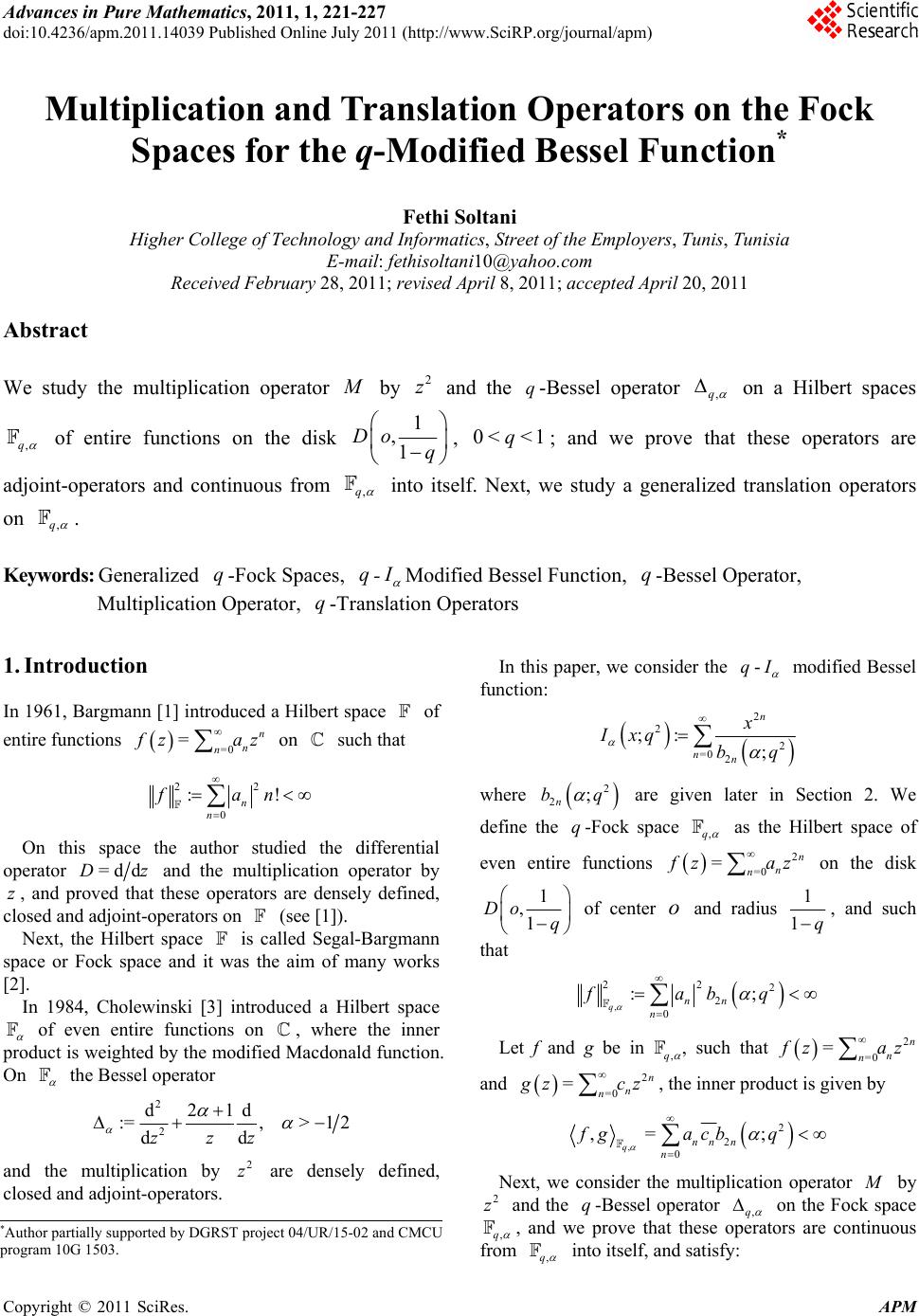 Advances in Pure Mathematics, 2011, 1, 221-227 doi:10.4236/apm.2011.14039 Published Online July 2011 (http://www.SciRP.org/journal/apm) Copyright © 2011 SciRes. APM Multiplication and Translation Operators on the Fock Spaces for the q-Modified Bessel Function* Fethi Soltani Higher College of Technology and Informatics, Street of the Employers, Tunis, Tunisia E-mail: fethisoltani10@yahoo.com Received February 28, 2011; revised April 8, 2011; accepted April 20, 2011 Abstract by and the -Bessel operator 2 z We study the multiplication operator q,q ,q on a Hilbert spaces of entire functions on the disk 1 q ,1 Do 0< <1q ,q , ; and we prove that these operators are adjoint-operators and continuous from ,q into itself. Next, we study a generalized translation operators on qq I . Keywords: Generalized -Fock Spaces, - Modified Bessel Function, -Bessel Operator, Multiplication Operator, -Translation Operators q q =0 n n n 1. Introduction In 1961, Bargmann [1] introduced a Hilbert space of entire functions = z az on such that 2 0 :! n n fan 2 On this space the author studied the differential operator =dD dz and the multiplication operator by , and proved that these operators are densely defined, closed and adjoint-operators on (see [1]). z Next, the Hilbert space is called Segal-Bargmann space or Fock space and it was the aim of many works [2]. In 1984, Cholewinski [3] introduced a Hilbert space of even entire functions on , where the inner product is weighted by the modified Macdonald function. On the Bessel operator 2 d21 2 d :=,>1 2 d dzz z 2 z q and the multiplication by are densely defined, closed and adjoint-operators. In this paper, we consider the - modified Bessel function: 2 2 2 =0 2 ;: ; n nn x Ixq bq where 2 2; n bq q,q are given later in Section 2. We define the -Fock space 2 =0 =n n n as the Hilbert space of even entire functions zaz on the disk 1 ,1 Do q of center o and radius 1 1q , and such that , 2 22 2 0 :; qnn n fabq ,q Let f and g be in , such that n 2 =0 =n n zaz 2 =0 =n n n and zcz , the inner product is given by , 2 2 0 ,= ; qnn n n fgacb q Next, we consider the multiplication operator by and the q-Bessel operator ,q 2 z on the Fock space ,q ,q , and we prove that these operators are continuous from *Author partially supported by DGRST project 04/UR/15-02 and CMCU rogram 1 0 G 1 50 3 . into itself, and satisfy: 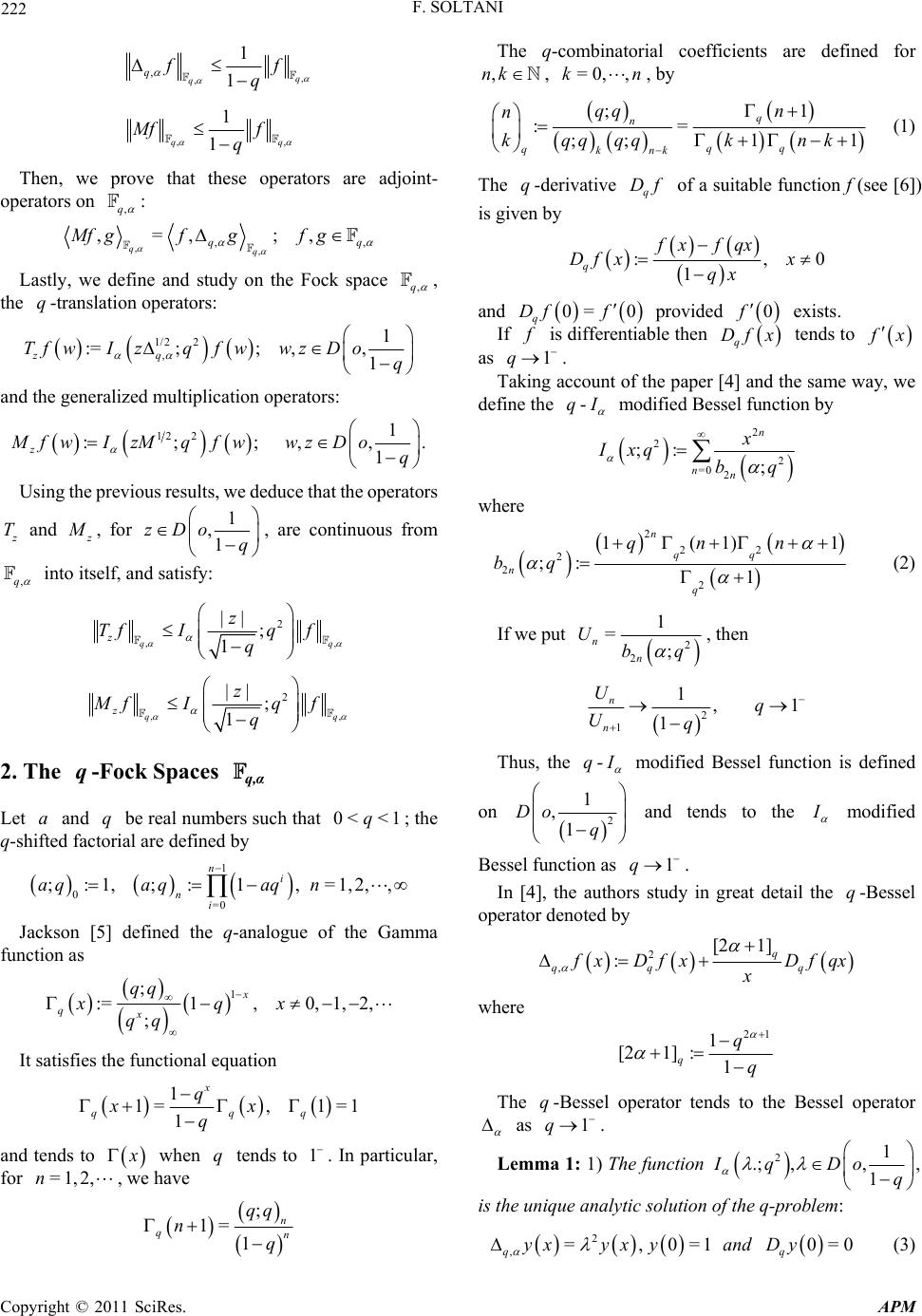 222 F. SOLTANI , 1 1q ff q , ,q q ,, 1 1 qq f q Mf Then, we prove that these operators are adjoint- operators on ,q : ,, ,=, qq Mf gfg ,, ;, qq f g ,q Lastly, we define and study on the Fock space q , the -translation operators: 1/2 2 , := ;; , zq Tf wIzqf wwz 1 ,1 D oq and the generalized multiplication operators: 12 2 :; ; z MfwI zMqfwwz 1 ,,. 1 Do q Using the previous results, we deduce that the operato rs T and , for 1 ,1 zDo q ,q , are continuous from into itself, and satisfy: , || 1 q z z Tf I, 2 ;q q f q ,, 2 ; qq q f q || 1 z z Mf I qq,α aq0< <1q ,=1,2,,n 2. The -Fock Spaces Let and be real numbers such that ; the q-shifted factorial are defined by 1 0=0 ;:1, ;:1 ni n i aq aqaq Jackson [5] defined the q-analogue of the Gamma function as 1 ; :=1 , ; x qx qq xq qq 0, 1, 2,x It satisfies the functional equation 1 1=1 x q q xx q , 1=1 q q and tends to when tends to 1. In particular, for , we have q =1,2, n ; 1=1 n n qq q ,nk qn The q-combinatorial coefficients are defined for =0,,kn , , by ;1 := ;;1 1 q n qq qknk qq n n kqqqqkn k qq Df (1) The -derivative of a suitable functio n f (see [6]) is given by :,0 1 q fx fqx Df xx qx 0= 0 q Df f provided exists. 0f f q Df x and If is differentiable then tends to x as 1q q . Taking account of the pap er [4] and the same way, we define the - modified Bessel functio n by 2 2 2 =0 2 ;: ; n nn x Ixq bq where 2 22 2 22 1(1) 1 ;: 1 n qq n q qn n bq (2) If we put 2 2 1 =; n n Ubq , then 2 1 1,1 1 n n Uq Uq q Thus, the - modified Bessel function is defined on 2 1 ,1 Do q and tends to the modified Bessel function as 1q q . In [4], the authors study in great detail the -Bessel operator denot ed by 2 , [2 1] :q qq q xDfx Dfqx x where 21 1 [21] :1 q q q q The -Bessel operator tends to the Bessel operator 1q as 2 .; . Lemma 1: 1) The function q ,1 ,1 Do q , is the unique analytic solution of the q-problem: 2 ,=,0=1 0=0 qq yxyxyand Dy (3) Copyright © 2011 SciRes. APM 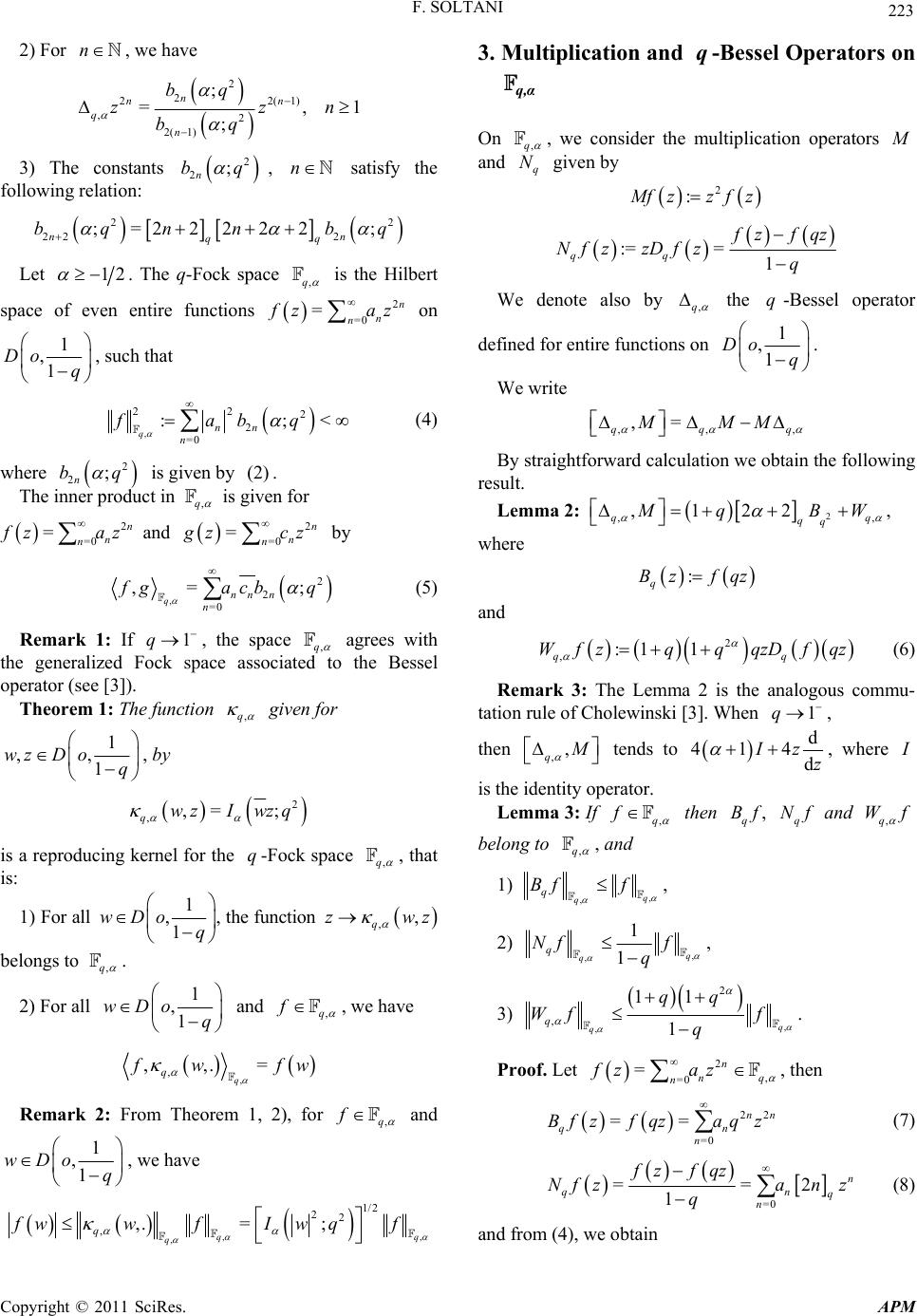 F. SOLTANI Copyright © 2011 SciRes. APM 223 n 2) For , we have 2 2 ,2 2( 1) ; ; n q n bq zz bq 22 (1) =, 1 nn n 2n 3) The constants , satisfy the following relation: 2; n bq 22 2 2 ; nn qq bq 22 ;=2222bqn n Let 12 , . The q-Fock space q is the Hilbert space of even entire functions 2 =0 =n n n zaz on 1 ,1 Do q , such that 2 ;< nn bq 2 , 2 2 2 =0 : qn fa (4) where is given by (2) . ; n b q 2 The inner product in ,q 2 is given for n ==0 n n z2 =0 =n n n az and zcz by 2 2; nnn ,=0 ,= qn ga cbq 1q (5) Remark 1: If , the space ,q ,q agrees with the generalized Fock space associated to the Bessel operator (see [3]). Theorem 1: The function given for 1 ,,1 D oq wz , by 2 ,= ;I wzq ,q , qwz is a reproducing kernel for the -Fock space q , that is: 1) For all 1 ,1 wDo q , the function ,, q wz belongs to ,q . 2) For all 1 ,1 oq wD ,q f and , we have , ,,.= q,q wfw ,q f Remark 2: From Theorem 1, 2), for and 1 ,1 wDo q , we have , , 2 ,,.= ; q q q fwwfI w, 1/2 2 q q f q q,α ,q 3. Multiplication and -Bessel Operators on On , we consider the multiplication operators and given by q N 2 : fz zfz :==1 qq fz fqz Nf zzDf zq ,q We denote also by the -Bessel operator defined for entire functions on q 1 ,1 Do q ,,, ,= qqq MMM . We write By straightforward calculation we obtain the following result. Lemma 2: 2 ,, ,122 qq qq qBW , where : q Bz fqz and 2 ,:1 1 qq Wfzqq qzDfqz 1q ,, q (6) Remark 3: The Lemma 2 is the analogous commu- tation rule of Cholewinski [3]. When , then tends to d 414 d zz , where is the identity operator. Lemma 3: If ,q f q B then , and Wf belong to q Nf ,q ,q , and , ,q q q Bf f 1) , , , 1 1q q q Nf f q 2) , 3) , , 2 , 11 1q q q qq Wf f q 2, =0 =n nq n fz az . Proof. Let 22 =0 ==nn qn n Bfzf qzaqz , then (7) =0 ==2 1 n qn q n fz fqz Nf zanz q (8) and from (4), we obtain  F. SOLTANI Copyright © 2011 SciRes. APM 224 , 22 2 =0 2 2 =0 q n qn n nn n Bfaq b ab , 42 2 2 =; ;q n q q f and , 22 =0 =2 q qn q n Nfa n 22 2; n b q Using th e fact that 1 2q n1q, we deduce , 22 22 11 1 q f q , 22 2 =0 ;= 1 q qnn n Nfa bq q 222 2nn q a nqz On the oth er hand from (6), we have ,=1 =1 1 qn n Wfzqq (9) and , 22 , 2 2 =1 =1 1 q q q n Wfqq an 2 42 2 2; n nn qbq Using th e fact that 1 21 q nq , we deduce that 22 ,2 ; n ab q , 2 2 2 2=1 11 1 q qn n qq Wf q Therefore, we conclude that , 2 q qq f q , , 11 1 q q Wf f which completes the proof of the Lemma. Theorem 2: If ,q then ,q and f belong to ,q , and we have 1) , 1 1q ff q , ,q q , 2) ,, 1 1 qq f q Mf 2, =0 n nq az . Proof. Let n fz . 1) From Lemma 1, 2), Then from (10), we get 2 2( 1) 2 2 2 2 ; ; ; ; n n bq z bq bq az bq 2 ,=1 21 22 1 =0 2 = = n qn nn n n nn fz a (10) , 2 222 22 ,122 2 =0 2 ; =; ; q n qn n nn bq abq bq Using Lemma 1, 3), we obtain , 222 ,1 22 =0 =22222; q qn n qq n annb q and consequently, , 222 ,2 =1 =222; q qn n qq n annb q (11) Using the fact that 2 1 2221 qq nn q , we obtain , , 1/2 22 ,2 =1 11 ;= 11 q q qnn n fabqf qq 2 1 =1 =n n n 2) On the other hand, since fza z (12) then , 22 222 12 22 =1 =0 =;= ; qnn nn nn fabqabq By Lemma 1, 3), we deduce , 222 2 =0 =22222; qnn qq n fannbq (13) Using the fact that 2 1 22222 1 qq nn q , we obtain ,, 1 1 qq Mf f q ,q f We deduce also the following norm equalities. Theorem 3: If then ,, 2 , ,=11 , qq qqq fWfqqN f Bf 1) , ,, , 22 ,=2, qqq qq qq q fNf NfBf 2) , ,,, 22 2=122 qqq qq q MfNfqB f 3) , 122 , q qq q qNfBf, ,,, 22 2 , =122 qqq qq q MffqB f 4) , , , q q fW f. 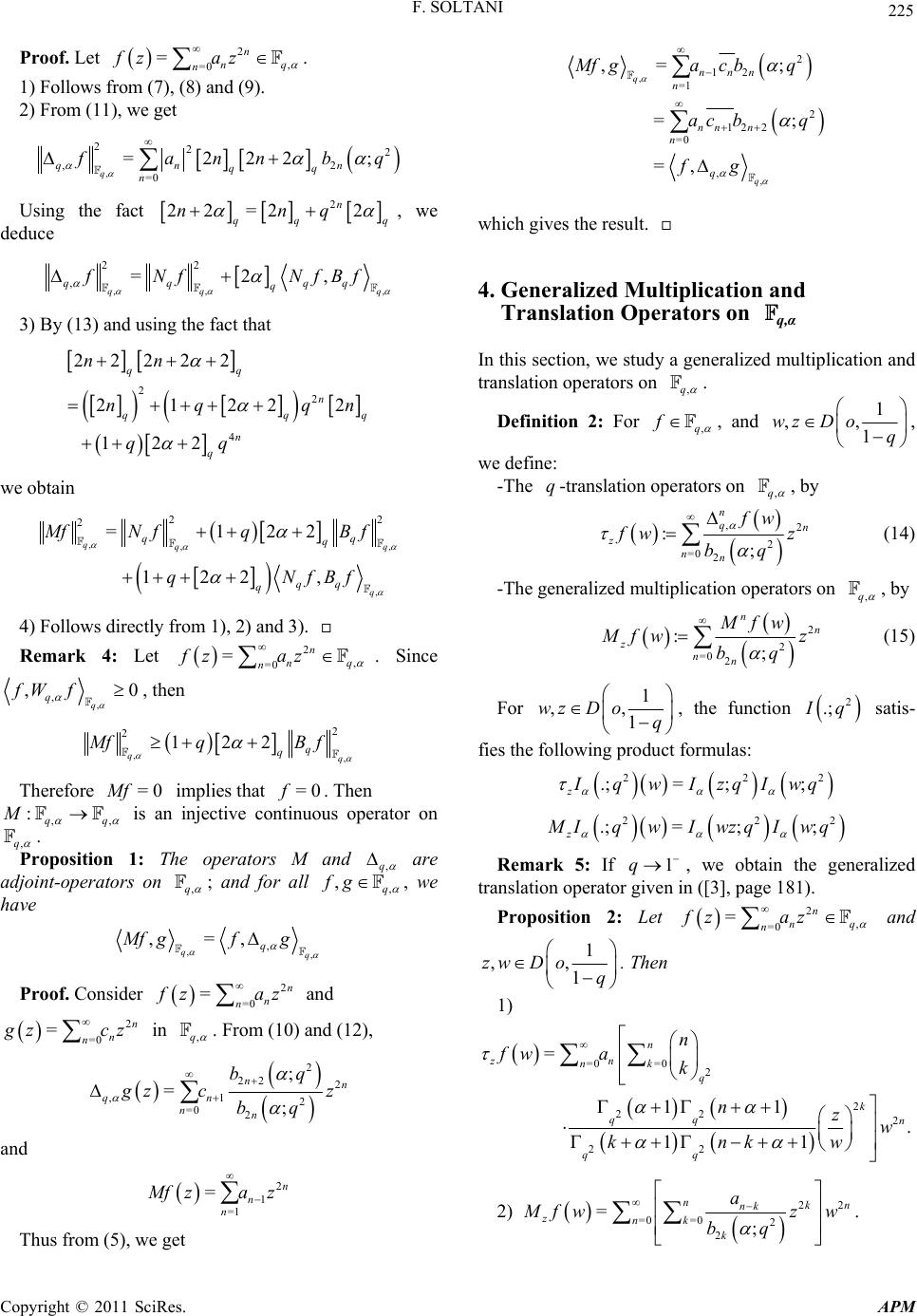 F. SOLTANI Copyright © 2011 SciRes. APM 225 2, =0 n nq az =n fzProof. Let . 1) Follows from (7), (8) and (9). 2) From (11), we get , 22 =0 =22 q qn n 2 ,2 2 ; n qq ann b q Using the fact 22 n qq q q22 =2nn , we deduce ,, 22 ,=2 qq qqq fNf , , q qq NfBf 3) By (13) and using the fact that 2 4 22222 212 122 qq n q nn nq qq 2 22 n qq q qn we obtain , 2=1 122 q q MfN fq qN ,, , 22 22 , qq q qq q qq B f fBf 2, =0 n nq az 4) Follows directly from 1), 2) and 3). Remark 4: Let =n fz . Since , ,0 q f ,q fW , then , 212 q Mf q , 2 2 q q qB f =0Mf=0f ,q Therefore implies that . Then ,q :M q is an injective continuous operator on , . Proposition 1: The operators M and ,q are adjoint-operators on ,q , ,q fg; and for all , we have , ,= q Mf g , , , q q f g 2 =0 =n n n Proof. Consider zaz and 2 =0 =n n n zcz q in , . From (10) and (12), 2 22 2 2 ; ; n n bq ,1 =0 2 =n qn n zc z bq 2 1 =1 =n n n and fza z Thus from (5), we get , , 2 12 =1 2 12 2 =0 , ,= ; =; =, q q nnn n nn n n q Mfgac bq ac bq fg q,α ,q which gives the result. 4. Generalized Multiplication and Translation Operators on In this section, we study a generalized multiplication and translation operators on ,q f . Definition 2: For , and 1 ,, 1 wzDoq q,q , we define: -The -translation operators on , by ,2 2 =0 2 :; n qn z nn fw wz bq ,q (14) -The generalized multiplication operators on , by 2 2 =0 2 :; n n z nn Mfw fw z bq (15) For 1 ,, 1 wzDoq 2 .; , the function q satis- fies the following product formulas: 222 .;= ;; z qwIzqIwq 222 .;= ;; z IqwIwzqIwq 1 Remark 5: If q 2, =0 =n nq n fz az , we obtain the generalized translation operator given in ([3], page 181). Proposition 2: Let and 1 ,, 1 zwD oq . Then 1) =0=0 2 2 22 2 22 = 11 . 11 n zn nk q k qq n qq n fw ak nzw knkw 2) 22 =0 =02 2 =; nkn nk znk k a fwz w bq . 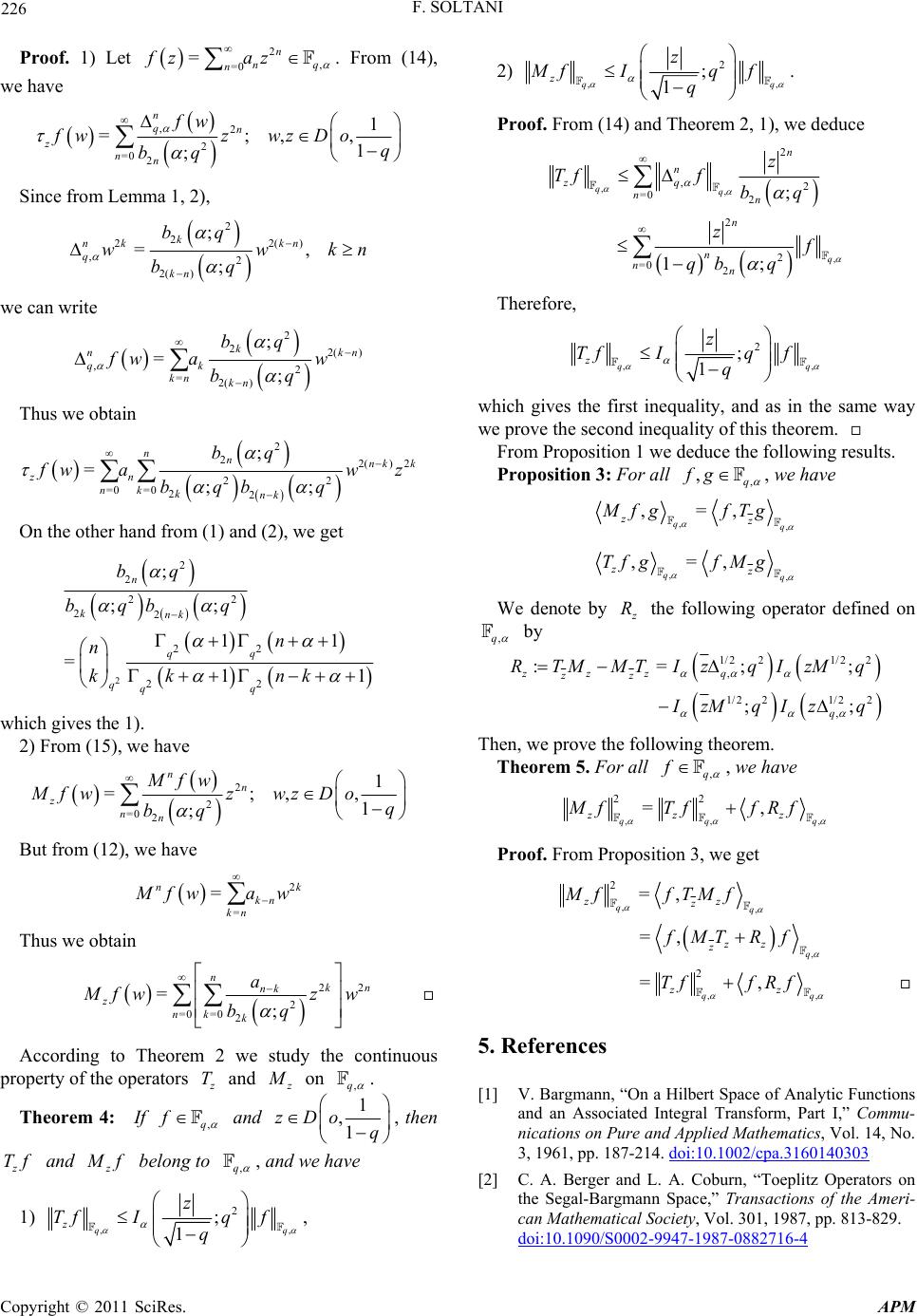 226 2, =0 n nq az F. SOLTANI Proof. 1) Let =n fz . From (14), we have ,, 2 ; 1 qq z z MfIq f q ,2 2 =0 2 =; ; n qn z nn fw fwz wz bq 1 ,, 1 Do q Since from Lemma 1, 2), 2 2 22 ,2 2( ) ; ; k nk q kn bq ww bq () =, kn kn we can write 2 2( ) 2 ; ; nk n bq w bq 2 ,=2( ) =k qk kn kn fw a Thus we o btain 2 2 2 =0=0 22 ; =;; nn zn nk knk bq 2( ) 2 2 nk k wa bqb wz q On the other hand from (1) and (2), we get 2 2 2 22 22 22 22 ; ;; = n knk qq qqq bq bqb q n k 11 11 n kn k which gives the 1). 2) From (15), we have 2 2 =0 2 =; ; n n z nn Mfw Mfwz wz bq 1 ,, 1 Do q 2 = = nk kn kn But from (12), we have fwa w Thus we o btain 22 2 kn =0=0 2 =; n nk z nk k a fw z w bq According to Theorem 2 we study the continuous property of the operators T and on ,q . Theorem 4: If ,q f and 1 ,1 zDo q , then and z Tf z f belong to ,q , and we have 1) ,, 2 ; qq q f q1 z z Tf I , 2) . Proof. From (14) and Theorem 2, 1), we deduce ,, , 2 ,2 =0 2 2 2 =0 2 ; 1; qq q n n zq nn n n nn z Tff bq zf qb q Therefore, ,, 2 ; 1 qq z z TfIq f q , ,q fg which gives the first inequality, and as in the same way we prove the second inequality of this theorem. From Proposition 1 we deduce the following results. Proposi t ion 3: For all , we have ,, ,=, qq zz Mfg fTg ,, ,=, qq zz Tf gf Mg We denote by R ,q the following operator defined on by 1/221/2 2 , 1/2 21/22 , :=;; ;; zzz q zz q RTMMTIz qIzMq zMq Izq ,q f Then, we prove the followi n g theorem. Theorem 5. For all , we have ,, , 22 =, qqq zz z Mf TffRf Proof. From Proposition 3, we get ,, , ,, 2 2 =, =, =, qq q qq zz z zz z zz Mf fTMf fMT Rf Tff Rf 5. References [1] V. Bargmann, “On a Hilbert Space of Analytic Functions and an Associated Integral Transform, Part I,” Commu- nications on Pure and Applied Mathematics, Vol. 14, No. 3, 1961, pp. 187-214. doi:10.1002/cpa.3160140303 [2] C. A. Berger and L. A. Coburn, “Toeplitz Operators on the Segal-Bargmann Space,” Transactions of the Ameri- can Mathematical Society, Vol. 301, 1987, pp. 813-829. doi:10.1090/S0002-9947-1987-0882716-4 Copyright © 2011 SciRes. APM 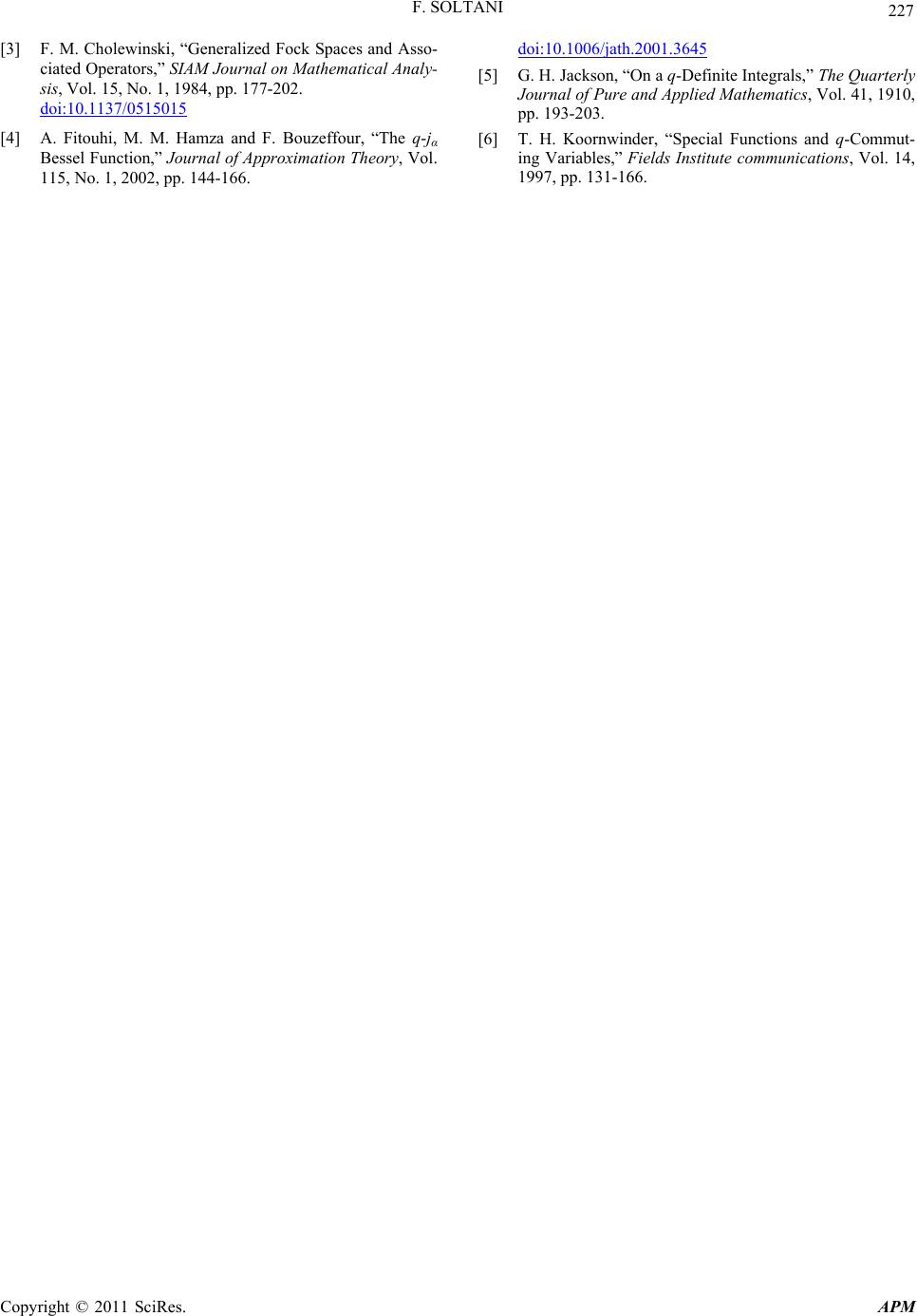 F. SOLTANI Copyright © 2011 SciRes. APM 227 [3] F. M. Cholewinski, “Generalized Fock Spaces and Asso- ciated Operators,” SIAM Journal on Mathematical Analy- sis, Vol. 15, No. 1, 1984, pp. 177-202. doi:10.1137/0515015 [4] A. Fitouhi, M. M. Hamza and F. Bouzeffour, “The q-jα Bessel Function,” Journal of Approximation Theory, Vol. 115, No. 1, 2002, pp. 144-166. doi:10.1006/jath.2001.3645 [5] G. H. Jackson, “On a q-Definite Inte gral s,” The Quarterly Journal of Pure and Applied Mathematics, Vol. 41, 1910, pp. 193-203. [6] T. H. Koornwinder, “Special Functions and q-Commut- ing Variables,” Fields Institute communications, Vol. 14, 1997, pp. 131-166.
|